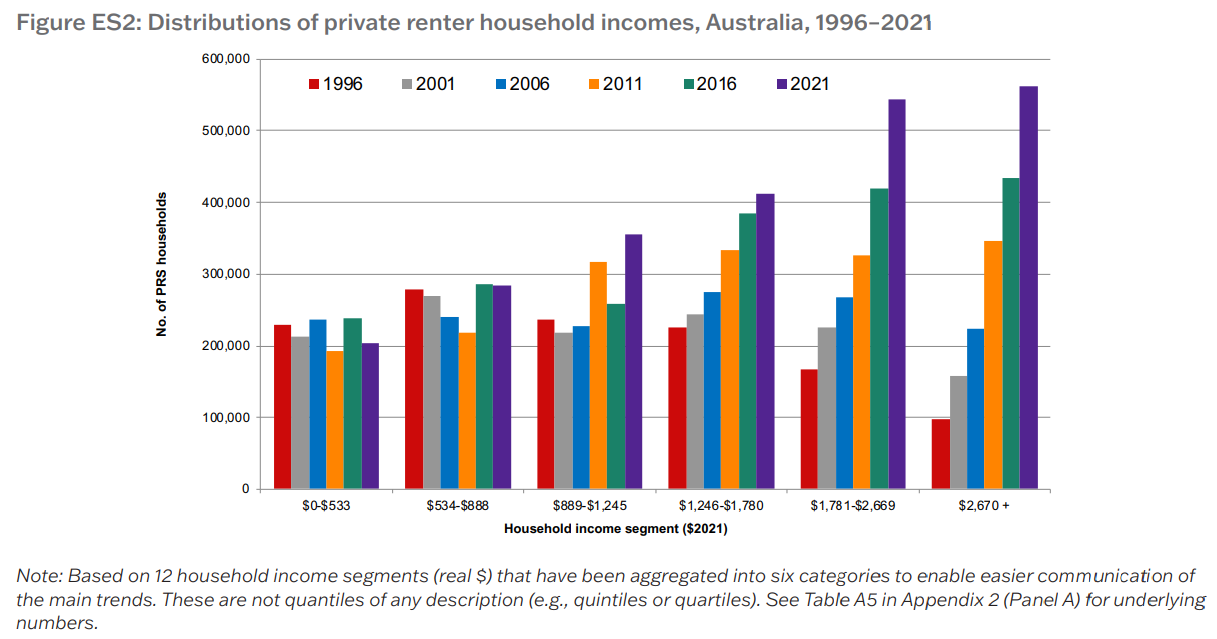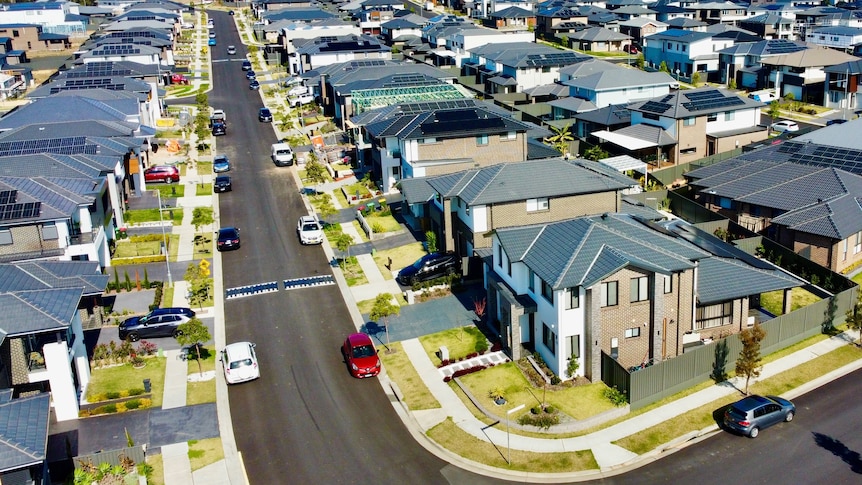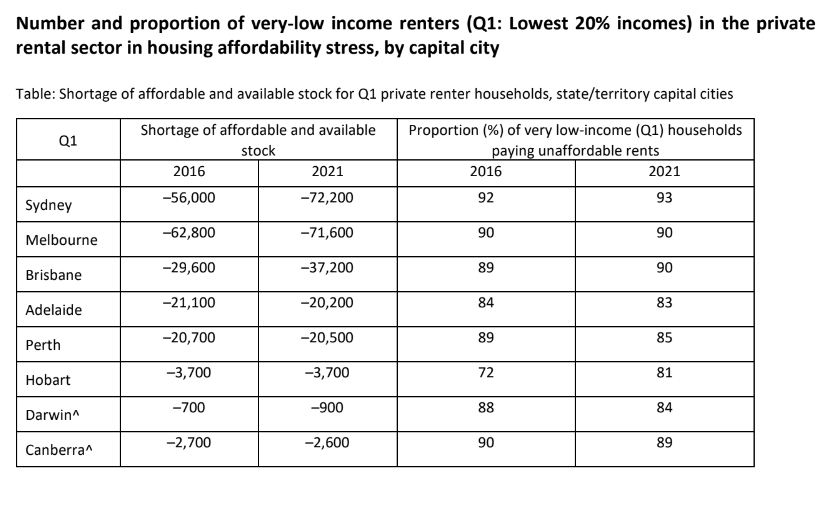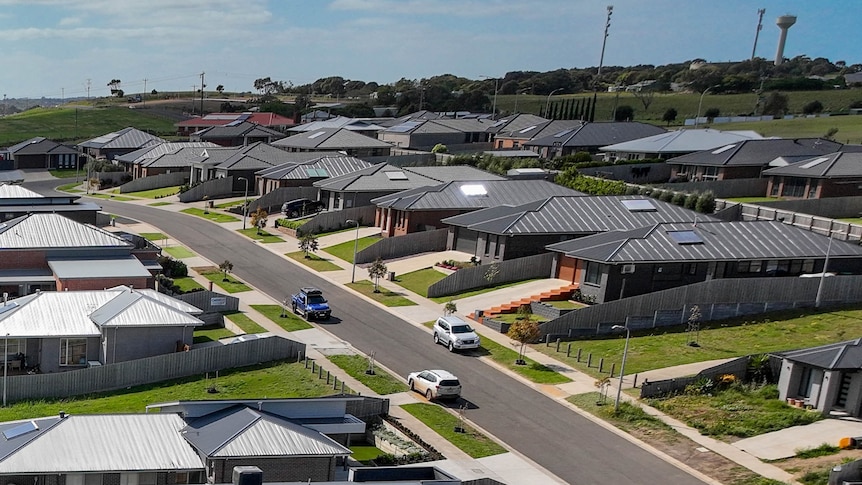If you’re someone who rents, this information won’t come as a shock.
We Depend More on Dual Incomes for Renting
Renting trends and household income are at the forefront of the latest research findings unveiled recently. Conducted by experts from Swinburne University of Technology and the University of Tasmania on behalf of AHURI, this study is part of a comprehensive analysis spanning from 1996 to 2021. The research delves into the evolving landscape of affordable private rental housing and the increasing necessity for dual incomes to afford it.
The term “affordable” in this context signifies a weekly rent that does not exceed 30% of the total household income. Over the years, there has been a noticeable upward trajectory in the number of households in the private rental market with moderate to high weekly gross incomes ($1,246 and above in 2021), as illustrated in the accompanying graphic.

The private rental market has experienced substantial growth in households with mid-to high-level incomes since 1996, according to the Australian Housing and Urban Research Institute’s report on “Affordable private rental supply and demand: short-term disruption (2016–2021) and longer-term structural change (1996–2021).” Lower-income households are facing challenges competing with those in higher income brackets when it comes to selecting rentals across different price ranges. In 2021, there was a shortage of 255,000 affordable private rental homes for renters in the bottom 20% of the income distribution. However, this shortage increased to 348,000 homes that were both affordable and available after considering the utilization of housing stock by higher-income households. Out of the total 425,000 renting households in the lowest 20% of income brackets in 2021, only 77,000 managed to secure an affordable rental. The remaining 348,000 households (82%) were experiencing housing affordability stress, paying more than 30% of their income in rent. Research author Margaret Reynolds from Swinburne University highlighted that not all lower-priced rentals are accessible to households with the lowest incomes, as many of these properties are occupied by higher-income households, exacerbating the shortage of affordable homes. The report also noted a significant increase in renting households with high incomes of $140,000 per year and above in 2021, rising from 8% in 1996 to 24% in 2021.
Impacts of Housing Crisis Extend to Homeowners

Exploring Renting Trends and Household Income
According to the report, the affordability crisis faced by the lowest-income renters may be underestimated at the household level. This is because many low-income renters have shifted away from traditional rental options over time, opting for informal arrangements with family, friends, or alternative living situations.
Low-income renting households primarily consist of single individuals or single-earner households at various life stages, including both younger and older age groups. These households often rely on statutory incomes or part-time earnings for financial support.
Specific groups within these low-income renters include single welfare recipients like JobSeeker beneficiaries, individuals receiving age and disability pensions, couples receiving welfare assistance, and single parents with one child who receive parenting payments.
The researchers highlight that Australia’s informal rental sector plays a significant role in accommodating these lowest-income renters. Despite potential discounts or cost trade-offs compared to traditional rentals, many individuals in informal arrangements still struggle with unaffordable rent payments.
Furthermore, the researchers note a noticeable decrease in single renters within the mainstream rental sector. This shift underscores the growing need for dual incomes not only to pursue homeownership but also to afford rental payments.
This trend also suggests a lack of suitable affordable housing options for single individuals who may prefer larger dwellings beyond single-bedroom units. Additionally, there are limited affordable choices for single-parent families in need of multiple rooms.
The Impact of Renting Trends on Household Income
Collectively, researchers suggest that policymakers cannot address the significant housing challenges faced by low-income renters solely through private markets.
According to the study’s long-term evaluation of affordable rental availability, it highlights the compounding effects of ‘market failure.’ Relying on the private sector to meet the fundamental housing needs of an expanding portion of the population, including elderly individuals, is deemed socially and economically unsustainable.
Over time, the market inadequacies will not resolve the growing intergenerational disparities that hinder long-term renting households from transitioning to homeownership. Simultaneously, it will impede many individuals with the lowest incomes from entering the rental market.

Challenges in Housing Policy and Market Dynamics
Current market conditions and policy frameworks fall short in addressing the significant institutional hurdles ahead, particularly in terms of how housing taxation and incentives are shaped by the financialization of housing as an asset class.
There is a pressing need for policy innovation that can drive lasting transformations in the housing sector, much like the strategic responses required to combat the complexities of climate change.
Researchers highlight a trend observed over several crisis periods since 1996, where policymakers have leaned on the rental sector to absorb economic shocks. However, post-recovery, the rental sector has not progressed but rather regressed, especially for households with lower incomes.
Looking ahead, a critical question arises concerning Australia’s private rental sector: How sustainable is a sector initially designed as a temporary and adaptable component of the housing system, now tasked with providing stability, security, and affordability for a growing population across various demographics, urban areas, and regions?
For more insights on renting trends and their impact on household income, please visit our site 60time.com. And please don’t forget to follow us on social media at Facebook.



